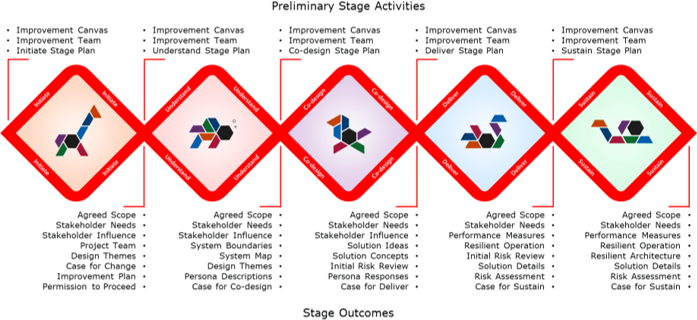Improvement is the process by which the current performance of a system is transformed into something measurably better, and can be described by the same simple, stage-based framework proposed in Engineering Better Care.
The stages of the improvement process may be considered as a collection of activities, executed in some form of order to ensure the efficient and effective running of the process based on the desired outcome and the availability of resources. Each of the stages will have a specific beginning and corresponding goal to enable the delivery of an improved system.
The overall process may range from the improvement of a well defined local system to the design of a new extended system of systems. In all cases there is a need to understand the current performance (or absence of performance for a new system), define a target for what is measurably better and capture the trigger for the improvement. The process may also be divided into a number of stages: to focus delivery on interim outcomes; to review and accept such outcomes; and to authorise continuation of the improvement programme.
The improvement process, by its very nature, comprises a number of stages that are typically, but not always, delineated by gates. These gates provide an opportunity to review the work of the previous stage prior to beginning the next, and often provide guidance as to the minimum standard required to proceed. In practice, some processes contain gates that are used more for pragmatic review, while others require specific information to be provided or progress to be attained.
Stage-based processes provide structure for improvement initiatives and, at a basic level, help to drive and monitor progress. They typically describe a linear process, emphasising the needs of each stage. However, in practice, improvement is rather more iterative in nature and strict adherence to a linear process can increase, rather than decrease, the risk of delivering effective change. Insights gained from early consideration of the later stages should inform the early stages of the process, and some degree of planned iteration is beneficial, whilst broadly executing the stages in order.
This guide provides a practical translation of this process and assists in the definition, visualisation, planning and execution of the whole or any particular stage of the improvement journey. The questions and activities highlighted provide a minimum suggested set and may be supplemented with other familiar activities.
Further Introductory Guides have been developed for each stage of the improvement process. They suggest specific activities for each of these stages, as well as the key questions that are of particular relevance to that stage. Other activities may be included, based on the experience of the team, or the particular needs of the improvement programme. Alternative or additional outputs can also be specified. Looking forward to understand the needs of later stages and iterating back to revisit previous stages is strongly encouraged. These guides may be found in the Improvement Stages section of this toolkit.
The definition of the gates provides a useful checklist for each stage. Outputs may be suggested for the early part of the stage, such as the Improvement Canvas, Improvement Team and Stage Plan, and as specific requirements for the end of the stage.
It is important to develop an Improvement Canvas for each stage of the programme and use this to identify stakeholders, and their needs, and the Improvement Team that are best skilled or available to deliver the programme. The skills and leadership required for the Initiate, Understand and Co-design stages are likely be very different to those required for the Delivery and Sustain stages, as are the key stakeholders, performance measures and the corresponding case for improvement.
This toolkit contains a variety of resources that can be used at all stages of the improvement process, ranging from introductory guides to a comprehensive selection of tools, activities, definitions and personas. Short commentaries on important topics and case studies provide further insight into the practical application of a systems approach to improvement.
Feedback
We would welcome your feedback on this page:
Privacy policy. If your feedback comments warrant follow-up communication, we will send you an email using the details you have provided. Feedback comments are anonymized and then stored on our file server
Read more about how we use your personal data. Any e-mails that are sent or received are stored on our mail server for up to 24 months.



